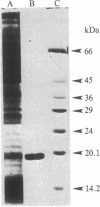Abstract
The highly potent bell pepper odorant 2-isobutyl-3-[3H]methoxypyrazine [( 3H]IBMP) binds specifically and saturably to bovine and rat nasal epithelium. Specific binding is not detected in 11 other tissues assayed, and in the rat binding is 9 times higher in olfactory than in respiratory epithelium. We have purified to apparent homogeneity a soluble pyrazine odorant binding protein that constitutes approximately equal to 1% of the total soluble protein in bovine nasal epithelium. Polyacrylamide gel electrophoresis shows a single band of 19,000 Da and gel filtration data suggest that the native protein is a dimer of 38,000 Da. Binding of [3H]IBMP to the purified protein reveals two binding sites (Kd = 10 X 10(-9) M, Bmax = 135 pmol per mg of protein; Kd = 3 X 10(-6) M, Bmax = 25 nmol per mg of protein). The binding affinities of a homologous series of pyrazine odorants correlate with the human odor detection thresholds of these compounds. This correlation, together with the regional distribution of the protein, suggests that the protein is a physiologically relevant olfactory receptor.
Full text
PDF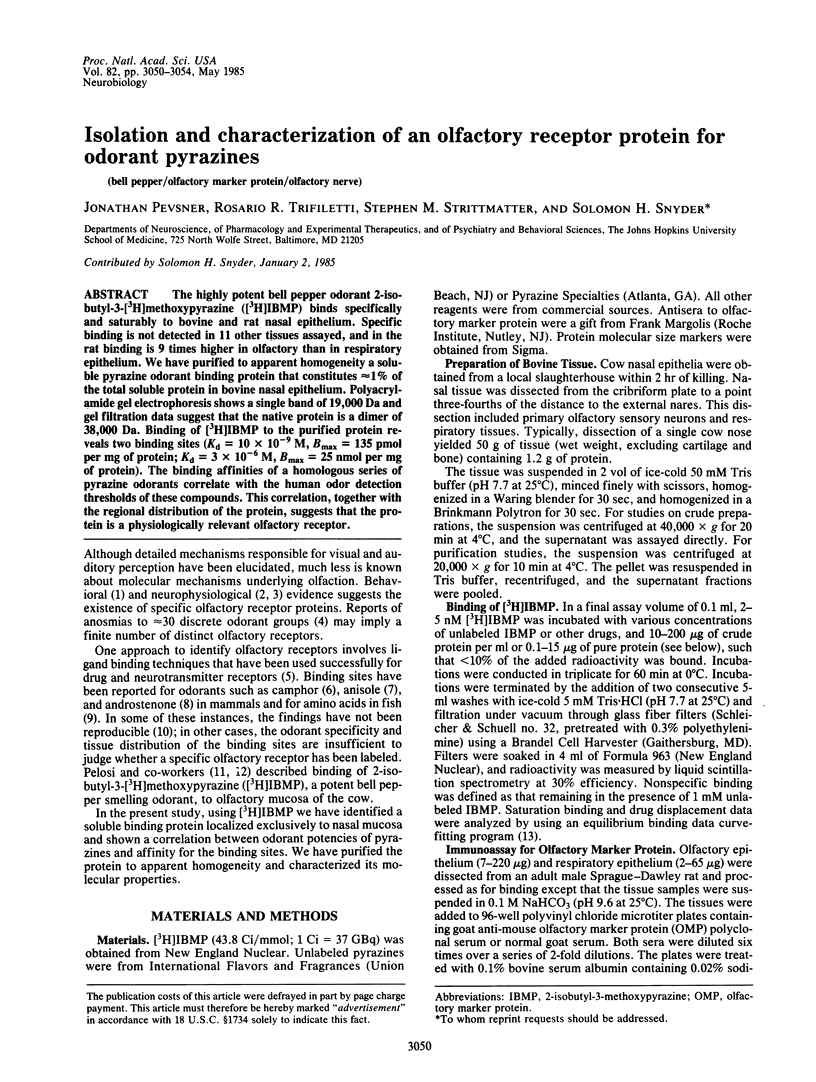
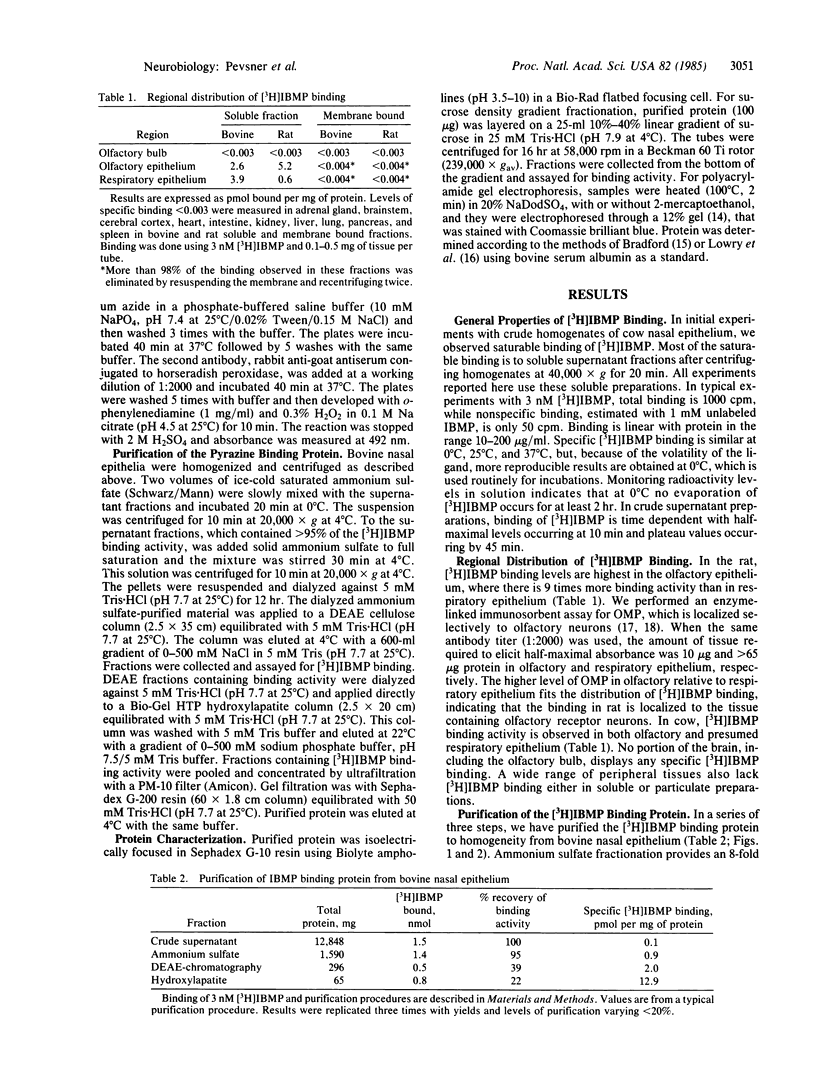
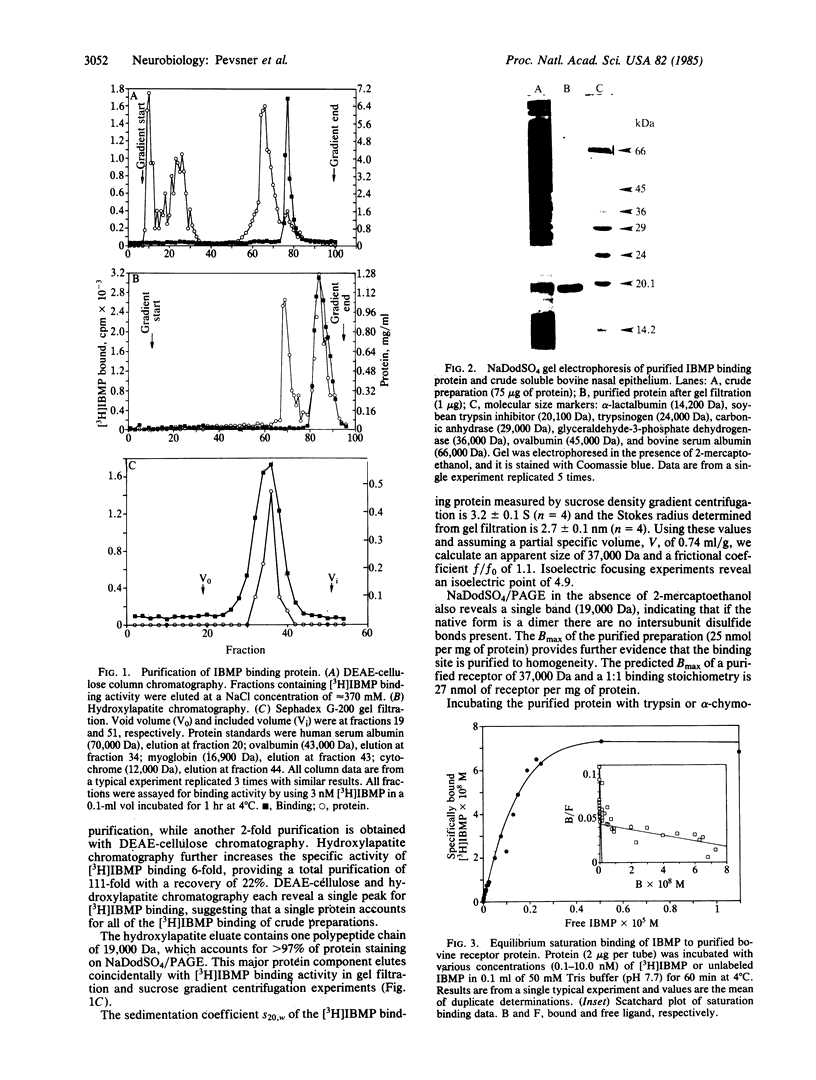
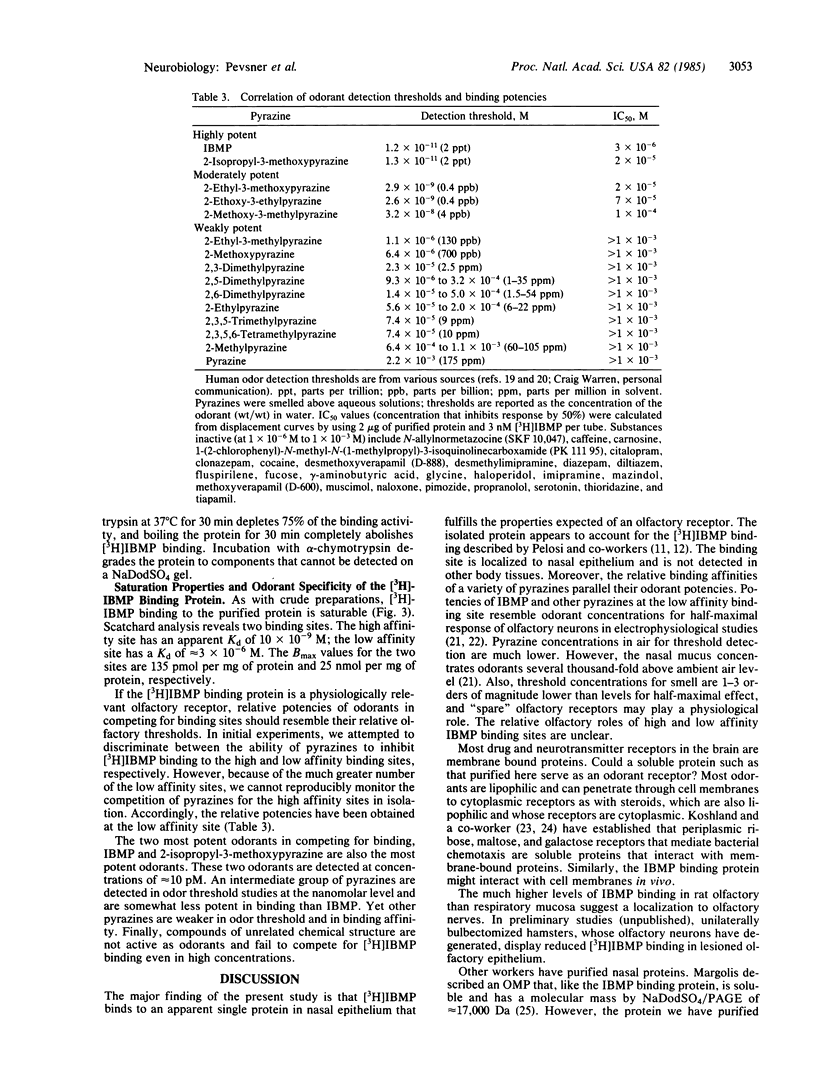
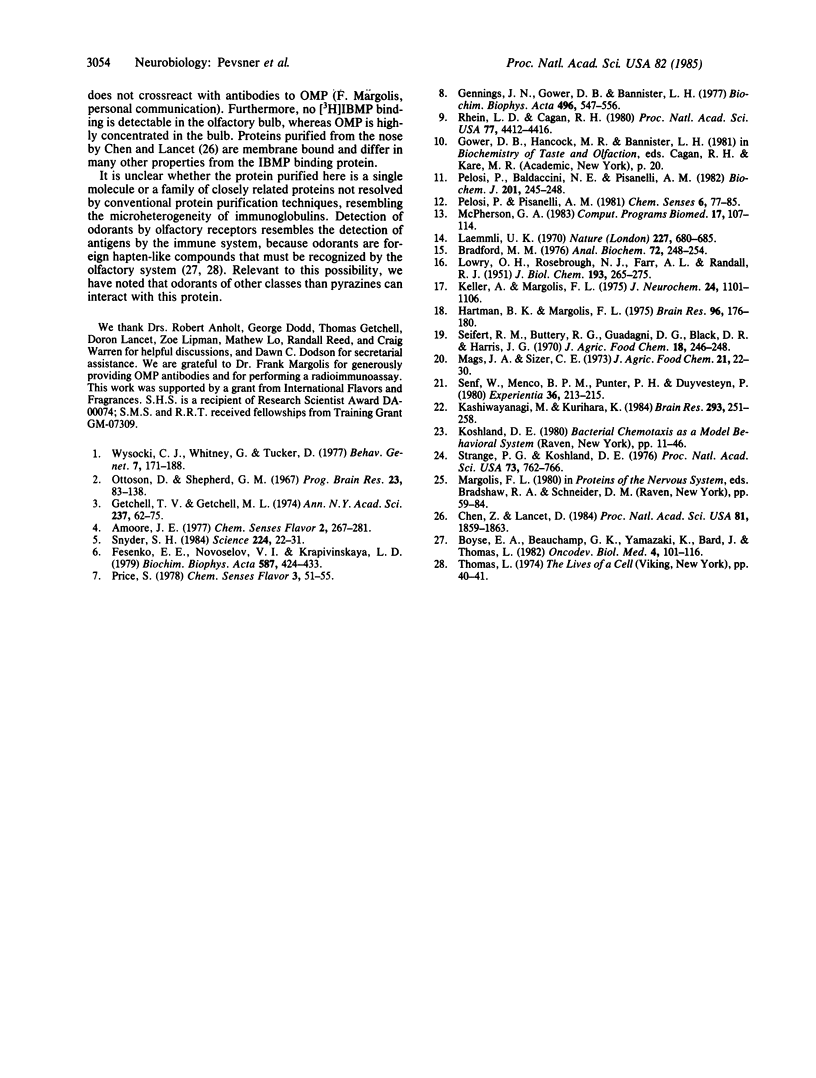
Images in this article
Selected References
These references are in PubMed. This may not be the complete list of references from this article.
- Boyse E. A., Beauchamp G. K., Yamazaki K., Bard J., Thomas L. Chemosensory communication. A new aspect of the major histocompatibility complex and other genes in the mouse. Oncodev Biol Med. 1982;4(1-2):101–116. [PubMed] [Google Scholar]
- Bradford M. M. A rapid and sensitive method for the quantitation of microgram quantities of protein utilizing the principle of protein-dye binding. Anal Biochem. 1976 May 7;72:248–254. doi: 10.1006/abio.1976.9999. [DOI] [PubMed] [Google Scholar]
- Chen Z., Lancet D. Membrane proteins unique to vertebrate olfactory cilia: candidates for sensory receptor molecules. Proc Natl Acad Sci U S A. 1984 Mar;81(6):1859–1863. doi: 10.1073/pnas.81.6.1859. [DOI] [PMC free article] [PubMed] [Google Scholar]
- Fesenko E. E., Novoselov V. I., Krapivinskaya L. D. Molecular mechanisms of olfactory reception. IV. Some biochemical characteristics of the camphor receptor from rat olfactory epithelium. Biochim Biophys Acta. 1979 Oct 18;587(3):424–432. doi: 10.1016/0304-4165(79)90446-x. [DOI] [PubMed] [Google Scholar]
- Gennings J. N., Gower D. B., Bannister L. H. Studies on the receptors to 5alpha-androst-16-en-3-one and 5alpha-androst-16-en-3alpha-ol in sow nasal mucosa. Biochim Biophys Acta. 1977 Feb 28;496(2):547–556. doi: 10.1016/0304-4165(77)90335-x. [DOI] [PubMed] [Google Scholar]
- Getchell T. V., Getchell M. L. Signal-detecting mechanisms in the olfactory epithelium: molecular discrimination. Ann N Y Acad Sci. 1974 Sep 27;237(0):62–75. doi: 10.1111/j.1749-6632.1974.tb49844.x. [DOI] [PubMed] [Google Scholar]
- Hartman B. K., Margolis F. L. Immunofluorescence localization of the olfactory marker protein. Brain Res. 1975 Oct 10;96(1):176–180. doi: 10.1016/0006-8993(75)90593-4. [DOI] [PubMed] [Google Scholar]
- Kashiwayanagi M., Kurihara K. Neuroblastoma cell as model for olfactory cell: mechanism of depolarization in response to various odorants. Brain Res. 1984 Feb 20;293(2):251–258. doi: 10.1016/0006-8993(84)91232-0. [DOI] [PubMed] [Google Scholar]
- Keller A., Margolis F. L. Immunological studies of the rat olfactory marker protein. J Neurochem. 1975 Jun;24(6):1101–1106. doi: 10.1111/j.1471-4159.1975.tb03883.x. [DOI] [PubMed] [Google Scholar]
- LOWRY O. H., ROSEBROUGH N. J., FARR A. L., RANDALL R. J. Protein measurement with the Folin phenol reagent. J Biol Chem. 1951 Nov;193(1):265–275. [PubMed] [Google Scholar]
- Laemmli U. K. Cleavage of structural proteins during the assembly of the head of bacteriophage T4. Nature. 1970 Aug 15;227(5259):680–685. doi: 10.1038/227680a0. [DOI] [PubMed] [Google Scholar]
- McPherson G. A. A practical computer-based approach to the analysis of radioligand binding experiments. Comput Programs Biomed. 1983 Aug-Oct;17(1-2):107–113. doi: 10.1016/0010-468x(83)90031-4. [DOI] [PubMed] [Google Scholar]
- Ottoson D., Shepherd G. M. Experiments and concepts in olfactory physiology. Prog Brain Res. 1967;23:83–138. doi: 10.1016/s0079-6123(08)60664-0. [DOI] [PubMed] [Google Scholar]
- Pelosi P., Baldaccini N. E., Pisanelli A. M. Identification of a specific olfactory receptor for 2-isobutyl-3-methoxypyrazine. Biochem J. 1982 Jan 1;201(1):245–248. doi: 10.1042/bj2010245. [DOI] [PMC free article] [PubMed] [Google Scholar]
- Rhein L. D., Cagan R. H. Biochemical studies of olfaction: isolation, characterization, and odorant binding activity of cilia from rainbow trout olfactory rosettes. Proc Natl Acad Sci U S A. 1980 Aug;77(8):4412–4416. doi: 10.1073/pnas.77.8.4412. [DOI] [PMC free article] [PubMed] [Google Scholar]
- Senf W., Menco B. P., Punter P. H., Duyvesteyn P. Determination of odour affinities based on the dose-response relationships of the frog's electro-olfactogram. Experientia. 1980 Feb 15;36(2):213–215. doi: 10.1007/BF01953738. [DOI] [PubMed] [Google Scholar]
- Snyder S. H. Drug and neurotransmitter receptors in the brain. Science. 1984 Apr 6;224(4644):22–31. doi: 10.1126/science.6322304. [DOI] [PubMed] [Google Scholar]
- Strange P. G., Koshland D. E., Jr Receptor interactions in a signalling system: competition between ribose receptor and galactose receptor in the chemotaxis response. Proc Natl Acad Sci U S A. 1976 Mar;73(3):762–766. doi: 10.1073/pnas.73.3.762. [DOI] [PMC free article] [PubMed] [Google Scholar]
- Wysocki C. J., Whitney G., Tucker D. Specific anosmia in the laboratory mouse. Behav Genet. 1977 Mar;7(2):171–188. doi: 10.1007/BF01066005. [DOI] [PubMed] [Google Scholar]



